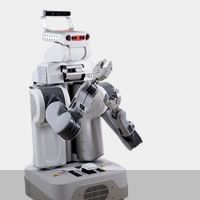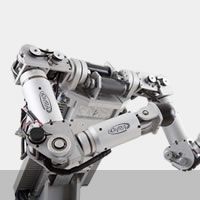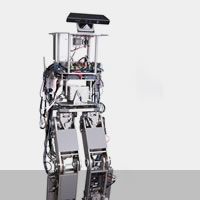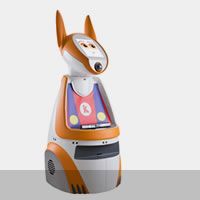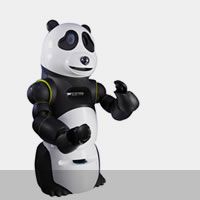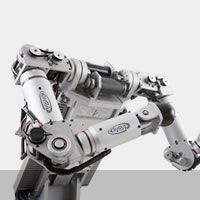Research
Research Achievements
Intelligent 3D Cognitive Semantic Map Exploration and Integration Service Robotic System for Assisted Elder Care Applications(II)
We implemented the object recognition architecture with the state-of-the-art robtic tool – ROS and use it recognize some commonly seen objects in our daily lives.
Object recognition research is not good enough, because of there are too many kinds of objects in the world so that object recognition problem is not easy to deal with. Because human can easily recognize objects with simple shape, but dealing with complex objects, human tends to divide this complex object into the combinations of simple objects.
Dual Arm Robot(II)
Analytical Inverse Kinematics Solution for Modularized Dual-Arm Robot With offset at shoulder and wrist
Generally, an industrial manipulator such as PUMA560 is equipped with 6 degrees of freedom(DoF), it is just enough to reach a position and orientation in 3-D space. However, to achieve dexterous movement like the upper limb of human, different with normal industrial manipulators, such manipulators equipped with 7-DoF kinematic structure is desirable. With the redundant joint, such manipulators may accomplish tasks such as obstacle-avoidance and singularity avoidance while reaching target position at the same time. These tasks are all about manipulator kinematics. However, when one wants to utilize advantages of redundant manipulators, one encounters problem of solving inverse kinematic problem of such manipulators. There is two ways to solve manipulator kinematic problem, one is numerical method and the other is analytical method. Traditionally, it used numerical method to deal with kinematics problem is a traditional way. However, solving Jacobian matrix is rather tedious, not to mention solving its inverse. Also, the relation between joint space and Cartesian space of an arm is not linear, obtaining joint values by numerical method is not satisfactory.
Biped Robot(II)
Stability Control with Pushing and Automatic Recovery Capabilities for a Biped Walking Robot
Biped walking robot realizes locomotion by its pair of legs with walking gaits similar to human beings. Because of these dynamic characteristics, compared with wheeled robots, biped walking robots possess a variety of merits, such as the capability of locomotion on irregular terrains and higher affinity to humans compared to wheeled robots. A problem that biped walking robots usually confront is unknown perturbation from the environment and human beings, which may seriously jeopardize the walking stability. The purpose of this project is to develop a system which takes advantages of the inner stability and posture change of the biped walking robot to make it capable of dealing with unexpected external disturbance and returning to its stable state.
Vision Robot(II)
Hybrid Eye-to-hand and Eye-in-hand Visual Servo System for Parallel Robot Conveyor Object Tracking and Fetching
This system aims at integrating robot arm and image processing algorithm for further application. The vision servo algorithm is proposed to recognize the workpiece on the conveyor. Meanwhile, the vision servo would apply both recognition and tracking method to estimate the position and orientation of the workpiece every frame. Taking the advantage of the proposed vision method, the robot arm could pick the workpiece on the belt after tracking in arbitrary ideal picking position. All workpieces in the belt are allowed to be arbitrary placed, and, the vision servo should detect the picking point and estimate the pose very accurately. As the result, workpieces would be arranged by specific order and pose by parallel robot. The descriptive condition above is special designed for industrial application. Hence the system are of much academic interest and applied value.
Education Entertainment Companion Robot(II)
Age Estimation Using Appearance Images for Human-Robot Interaction
There are many modern applications require the function of age estimation such as security control and surveillance monitoring, health care system and so on. In this study, we propose a method to classify human age using appearance images and apply it to the human-robot interactions. We first confirm that facial features based on craniology are not discriminative under the condition of seven age-groups classification. Next, our system is designed to have two stages. One is image preprocess stage; faces are detected and preprocessed. Our image database is from FG-NET and MORPH databases so that we have high degree of complexity in training dataset. Then images are trained by support vector machines (SVM). To have higher recognition rate, we train RBF (radial basis function) and linear kernel models at the same time, and decide the final results by F-measure based weighting policy. We also compare the age-group classification results with subjective questionnaires, and it demonstrates that the proposed system has better performance than human’s subjective estimation. For the purpose of human-machine interaction, we design a simple user interface to perform online age-group classification. The system can be applied on any computer or robot as long as it has a camera sensor.
BIO Robot(II)
With the advance of technology, the robotic arm has the advantages of high precision and is capable to execute continuous motions repetitively, there are many benefits when we use robotic arm to assist therapists to carry out the rehab plans. Except saving human resources we can provide more stable therapeutic quality when executing repetitive and continuous motion. By the control and evaluation system of the robotic arm, we can provide different therapies accord to the doctor’s diagnosis and evaluate patients’ rehab progress from the quantified data.
